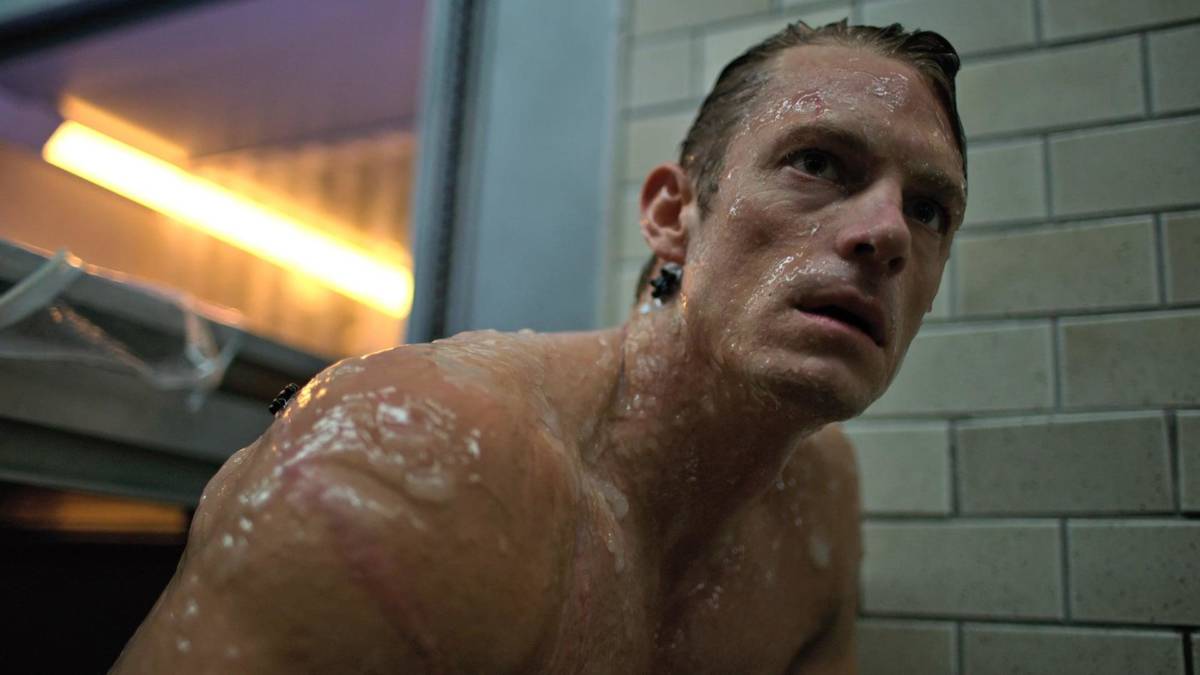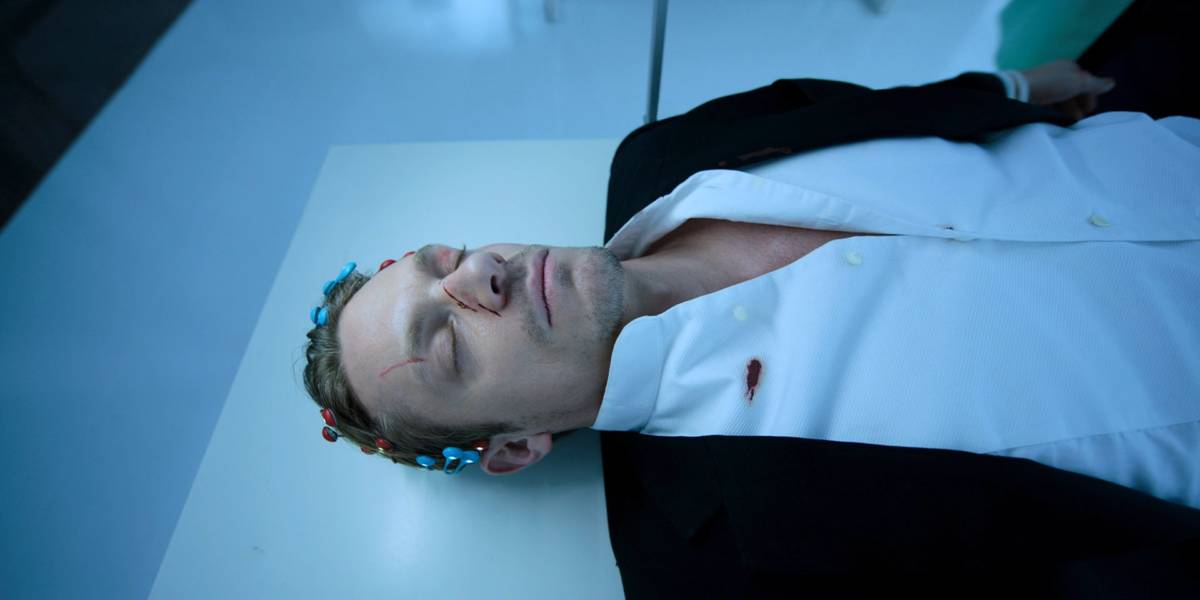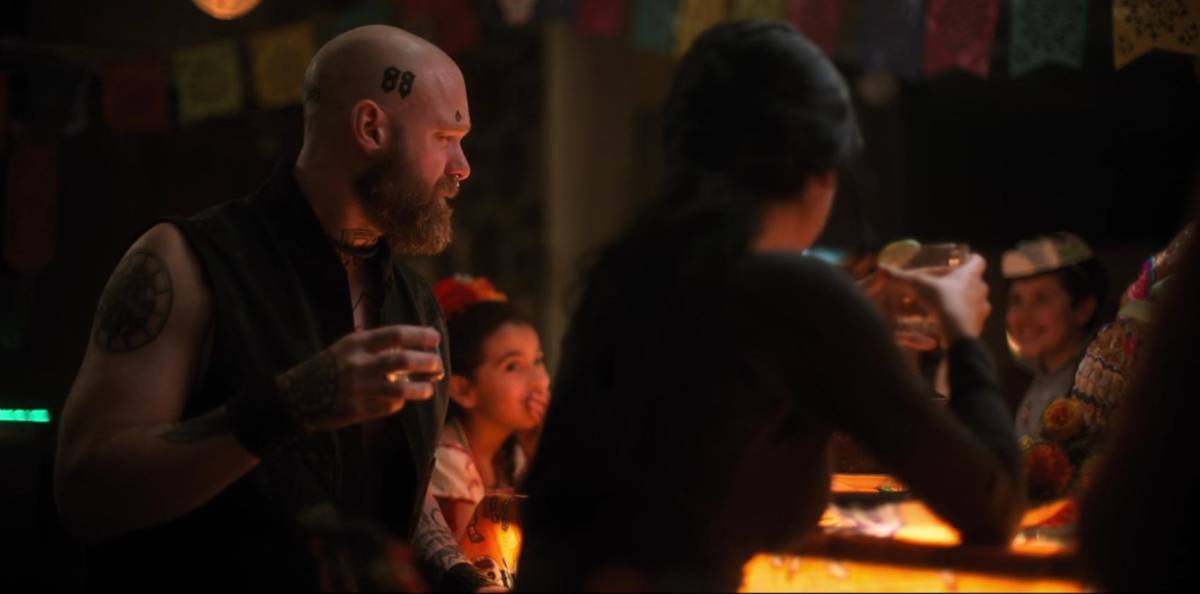On its own, Altered Carbon is a pretty average television show. Sure, it’s a serviceable way to kill a few hours. But held in relief to its corker of a premise – what kind of lives would we live when we no longer died? – Altered Carbon is a whopping disappointment. The series has spent three episodes squandering its clever thesis on a litany of tired tropes, wan characterization, and scene after scene of dumb and empty violence.
Having created a world suffused with the freight and wonder of eternal life, Altered Carbon’s only shown interest in telling stories about death. Which is what makes Force of Evil such a unique frustration. Half of the episode is the absolute best the show has been all season, while the other is the absolute, mind-numbing, stomach-wrenching puerile worst.
Let’s start with what works, shall we?
Is there Granny body in there?
Altered Carbon has danced around the theoretical ethics of sleeving for a few episodes, but up until now those considerations have remained either leadenly expository, or a mere excuse to further pornography physical violence. What works so well in Force of Evil is that sleeving tech is explored through the interactions of an actual family. We see how living with such miraculous technology actually works in the day to day, and how it makes people, ya know, feel. We see this through the unfolding drama of the Ortega family and their interactions with their recently rebooted abuelita – summoned back from the dead for dia de muertos, and uploaded into the nearest body available (in this case, a looming, tattoo-scribbled white guy).
In many ways, the scenes between him/her and the Ortega family are played for laughs. Mira! Abuelita’s peeing standing up! But look past the urological surface, and Altered Carbon is finally starting to take itself (and by extension, its viewers) seriously. In just a few well performed scenes, Force of Evil examines the emotional valences of a post-death culture through the rotating lens of family, faith, joy, and grief, and via the interactions of its actual characters.
By doing so, we finally begin to see the rejuvenative technology upon which nearly all of Altered Carbon’s drama is constructed for what it really is: wish fulfillment. A momentary fantasy we can all understand – because anyone who’s lost a loved one has felt it: the desire to pick up where our relationships were so ruthlessly curtailed. To have just a little more time. To sit across a table from our departed loves, and talk. Share a meal. Crack a joke. Just…be together.
I adored my grandmother. Everyone in my family did. She was enchanting, bonkers, a bit of a rascal; as kind and inviting as a rocking chair. A 5’ Yoda draped in a house dress, she was the personification of an Italian-American grandmother – perpetually singing songs to herself over a pot of bubbling marinara, a wooden spoon held in her papery hand. She died in 2003. I still have that spoon. Our family has grown by a factor of a few infants in the interim, and every holiday, as we sit around our table and play cards, we feel her palpable absence. We share a unique bond that’s formed of late: the longing to see her interact with the little ones. To watch as they learn the words to the songs she would sing. To see her bite their feet, and stroke their hair, wipe her eyes and whisper thanks for their life.
There’s genuine feeling at the heart of this storyline, something the series has been desperate for since its first cynical moments, and I welcome it gladly. In the end – after the debating and the goosing and pee jokes, and the laughter – we watch as Ortega’s reincarnated grandmother achieves something we can only dream of – she decides to turn her back on immortality, and move on to whatever’s next. Even if what’s next is nothing at all. Ortega and her grandmother split a joint, laugh together, and say their final goodbyes…and the result is absolutely stunning.
I cannot repeat this enough: this story (for all of its clunkiness) worked. It is absolutely the show I want to be watching.
Watch. Wince. Repeat.
 And yet…
And yet…
As I said earlier – Force of Evil manages to reach its best moment yet, as well as its absolute mind-numbing, forehead-slapping worst in the same damn episode. And for all of its deftness and tenderness, the Ortega storyline is overwhelmed by the narrative charnel porn of the episode’s A-story…wherein we behold as Kovacs is slowly tortured, again and again, over the course of an entire episode in a meandering cycle of gore, exposition, and just bad, boring writing.
I’ll make this part quick: His captor is a gangster who’s mistaken him for a man named Rikker, who was Ortega’s partner and sweetie. Throughout the episode, as Kovacs is beaten, immolated, mutilated, occasionally murdered, and rebooted, he flashes back to memories of when Quellcrist Falconer (that name…) tortured him in a similar VR prison, and through the magic of lies and violence, the two essentially confessed their love for each other. Nothing that’s depicted (not the torture, nor the flashbacks) are interesting enough to spend much time on. And as awful as a stultifying cycle of graphic physical torment may sound, it’s far from the episode’s nadir. So let’s get to what’s really, truly, bottomlessly awful here, shall we?
When last we saw Kovacs, he was being ruefully double-crossed by Anemone, who herself was quickly dispatched in a fit of superfluous violence (yet another dead woman; I’m going to start a counter). As this episode opens, we find Kovacs etherized upon a table and wheeled through the waxed linoleum halls of an outpatient torture center. Very little is explained about just what kind of company this is, how common an institution it may be or how deep into the Bay City demimonde it dwells, but judging by the drab design, workaday dealings of its employees, and the insipid muzak that dribbles from the speakers, it seems that this place is at least semi-legit.
As they slap electrodes to Kovacs’ head, we listen as two pasty wastrels trade hack lines of knowing misogyny. I’ll be blunt: the following scene very nearly made me stop watching Altered Carbon altogether, namely for how cheaply it deploys its cynicism, and how wretchedly privileged its irony is.
Consider: Here we watch two bros, cheerfully prepping a man for torture. As they work, one turns to the other and whispers, “Hey… I’m asking out that piece of ass from payroll. Ya know, the one with the…” And here he holds up two cupped hands, as though demonstrating the severity of his arthritis.
“Jesus, Miles,” his partner scolds, “they told you at sensitivity training you can’t talk about women like that.”
“I’m just expression for the female form. God.”
Ugh, just… shut up, Altered Carbon. Seriously.
The smug, knowing snark in this exchange is beneath even the most jugheaded middle-school reading level. It’s a bad joke, uninterestingly written and poorly performed, which dimensionalizes neither character, nor does it express what point of view the writer, director, or even the series has regarding such behavior. It’s just plain old infantile misogyny, lazily dressed up as some kind of satire or commentary.
Meanwhile: cut to a dead, nameless woman, sprawled naked upon a surgical chair. It’s not clear if the body is Anemone or some other woman altogether. We’re not given enough chance to figure it out. Suddenly a switch is thrown, an armature of robotic knives springs to life, and we witness as she’s vivisected bit by bit. As the episode plays on, we’re returned to the image of this woman, flash by flensing flash – a nameless corpse, reduced to a ruined mass of parts.
This is, in one image, everything that’s wrong with Altered Carbon: the violent, mechanical dismantling of a human body (again… a woman), with no notion or interest paid to her identity. On its own, it’s a just another moment in a litany of empty, graphic scenes meant to horrify and titillate. But when viewed In the context of the larger scene – juxtaposed as it is beside the knowing jokes and randy juvenilia of the two torturers – this image exposes Altered Carbon’s true face: crude, careless, and utterly sophomoric.
In the end, Kovacs breaks from his chains and slaughters everyone in the room. This, I suppose, is Altered Carbon’s answer to the lame moral calculus it’s presenting. See? They get theirs in the end. But one more scene of brutal violence is a remarkably unsatisfying solution to this episode. Especially when the question it’s attempting to answer is so totally opaque.
Some of the coverage you find on Cultured Vultures contains affiliate links, which provide us with small commissions based on purchases made from visiting our site.


